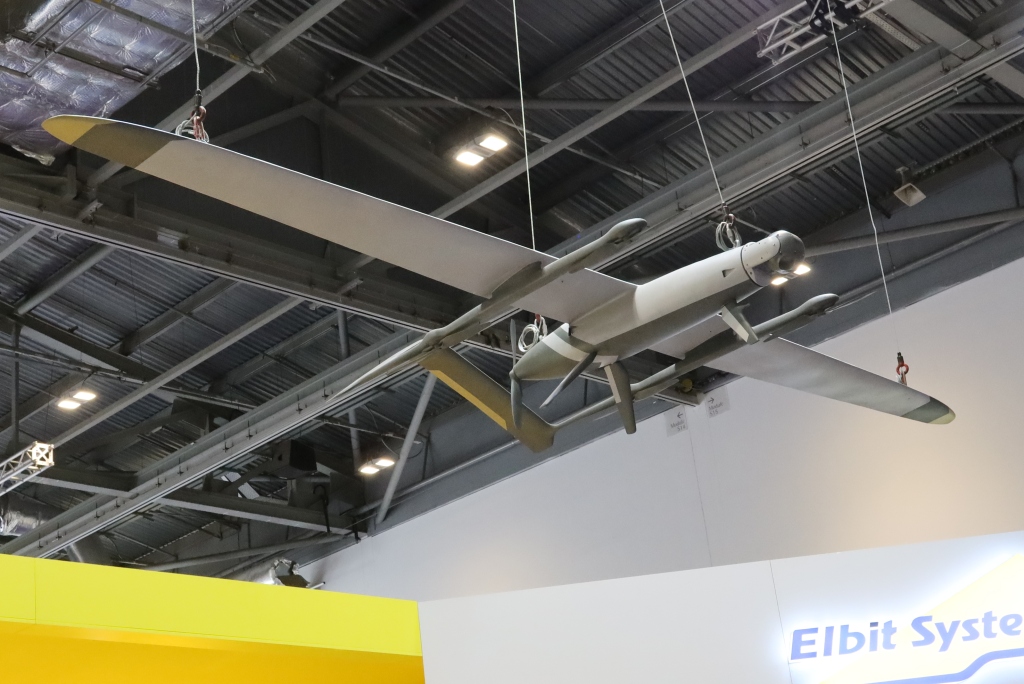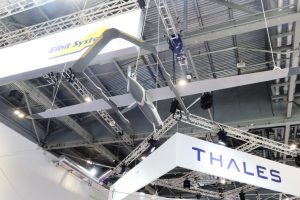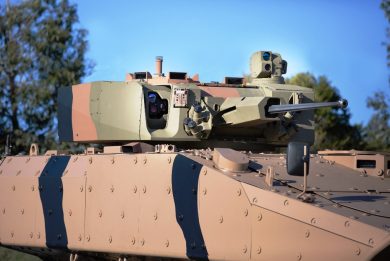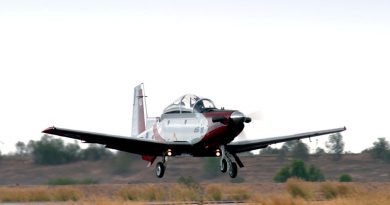
DSEI 2023 – Elbit Systems adds a new member to the Skylark family, the Skylark 1-eVTOL
Hanging from the ceiling over the Elbit Systems stand at DSEI 2023 was the last development of the Skylark family of UAS, the Skylark 1-eVTOL, which adds further flexibility to the company offer in this segment of unmanned air vehicles
With its Skylark 1 family of UAS sold to over 30 customers, Elbit Systems leveraged the experience acquired to further develop the last member of that family, the Skylark 1-LEX, into a vertical take-off and landing airframe.
In fact the architecture is quite different. The centre fuselage is fitted with a rear located electric motor driving a two-blade pushing propeller with the modular payload at the front. The straight wing comes in three pieces, the central one being fixed to the fuselage, the two semi-wigs being then added. At that point the two crew members add the two booms carrying the VTOL systems. These are fitted at the end of the wing central element, and host two electric motors each driving a rotor, which is located under the boom. It is to note that the two booms do not contain batteries, the VTOL electric motors being powered by the main battery used for the pushing propeller, Elbit considering that a single electric system was the optimal choice. At the rear the two booms carry the inverted-V tailplane.

EDR On-Line understood that the payload is higher than that of the fixed wing Skylark 1, up to 2.5 kg. During take-off the Skylark 1-eVTOL first rides in the air under the push of its four rotors, at which point the rear propeller starts turning and once aerodynamic lift is sufficient the transition is completed and the rotors stop turning. According to the company the UAS has very low radar, acoustic and visual signatures.
It can fly for three hours at a range of up to 40 km and at a maximum speed of 65 knots (120 km/h), up to a ceiling of 15,000 feet (4,500 metres).
It can carry a dual payload, typically a gimballed electro-optic one in the nose, which is fitted to the main part of the fuselage allowing for quick reconfiguration, while the second payload is hosted in a bay under the fuselage. This can be a small radar ensuring wide area scanning capability.
As the fixed-wing members of the Skylark family, the newcomer can carry out different types of missions such as target acquisition, fire adjustment, force protection, border protection, special operations support, maritime surveillance. It is fitted with automatic target tracking, the E/O suite providing high definition pictures, a laser designator being available as option.
The Skylark 1-eVTOL navigates using different types of satellite system, GPS, GLONASS, Galileo or others, however its position can also be estimated provided using the two-way advanced digital encrypted data link which allows operating in GPS-denied environment.
The new VTOL airframe exploits the same ground control station and data link used by other Skylarks as well as by the Skystriker loitering munition, which reduces costs and training when operated by a service that is already using UAS of the Elbit family.
Back from mission the Skylark 1-eVTOL slows down, rotors taking over the lift duty, and lands on a flat surface. According to Elbit data a 10 x 10 metres area is required, the airframe being capable to land on a naval ship light deck of reduced dimensions providing organic reconnaissance capabilities to the ship.
The Skylark 1-eVTOL can be quickly deployed by a two-man crew as it can be disassembled and carried in two backpacks, 15 minutes being required to assemble the airframe and make it ready to fly.
The new system is under contract from the Israel Defence Forces where it will replace the previous Skylark 1-LEX, first deliveries being awaited before the end of 2023. Elbit Systems also looks at its numerous export customers, who will have to acquire only the airframe as they will be capable to exploit the same ground section they already possess.
Photos courtesy P. Valpolini



